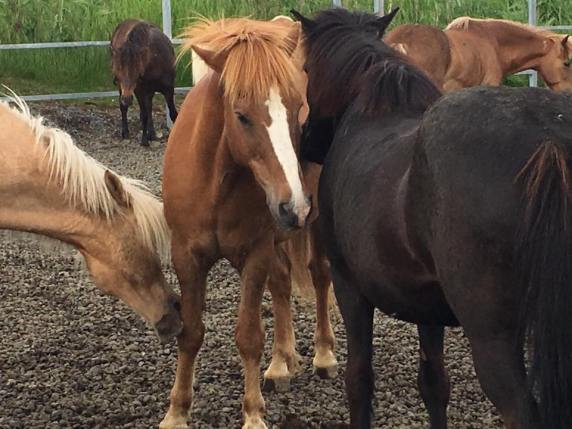“The noblest conquest of man is to have gained the friendship of the horse”.
Comte de Buffon
I’ve never ridden a horse before. The first time I do so, it happens to be an Icelandic horse.
The size of a pony, Icelandic horse is a unique breed of horses that came to Iceland with the Norse settlers in the 9th and 10th centuries. Isolated from disease and natural predators, the breed is strictly regulated to maintain its purity. Icelandic horse does five gaits, comes in many colors and is known for its spirited temperament and large personality.

My horse’s name is Sól and she is quite a character.

First step of horseback riding – getting to know your horses. I approached Sól careful. Pony-sized they say? Her raised head and long limb dwarf me. With hesitation, I petted her, which obviously wasn’t to her liking as she moved her head up and down, I backed off not knowing what to do next. They say that you should never let a horse know you are afraid. I might have just shown her my fear……This first bonding wasn’t going so well.
Once I mounted on the horse, things got a lot easier. I checked my foot position, made sure that I held the reins correctly, and the rest was easy. She took off immediately following others.

As we rode through lava field, our guide Begga pointed out the pseudocrater landscape that is unique of Iceland and…Mars. Pseudocraters are formed by steam explosions as flowing hot lava crosses over a wet surface, such as a swamp or a lake. The explosive gases break through the lava surface in a manner similar to a steam-blast eruption, and the tephra builds up crater-like forms which resemble real volcanic craters.
I also learnt that the fields of purple flowers we saw all over Iceland are actually not native plants. They are invasive species of Alaskan lupine originally brought into the country to counter soil erosion, but had since became a threat to local vegetation such as Icelandic moss and bilberry.
As we rode on, my tension eased. I started to get the knack of it and enjoyed every minute from then on – the thrill of wind flowing by, the rhythmic sound of trotting and a sense of freedom.
Sól has a way of doing things. She likes to fall behind until she’s almost the last horse in the group, then sped up and ran all the way to the front. As long as we were still with the group, I saw no reason to interrupt.
When we got back to the base, all the horses gathered together and mingled with one another.
Sól marched in front of me and rolled her back in the gravel. I took this as a sign of friendship, or just showing off 🙂
Volcanic Landscape Tour
ÍSLENSKI HESTURINN – The Icelandic Horse
Booking URL: http://islenskihesturinn.is/tour/volcanic-landscape/







Can’t believe those purple flowers are actually “weed”, they look so beautiful. And those ponies too cute ❤
LikeLiked by 2 people
I know. The colors really bright up the volcanic landscape. And those horses are adorable.
LikeLiked by 1 person
We have a similar flower here in Australia. Salvation Jane was brought to Australia by an early settler ( Jane Paterson) to brighten up her garden. It got out of control and spread like wildfire. Yes it has a beautiful blue/purple flower and it can be used is small quantities to feed sheep and cattle. It is, however toxic to horses and in Canberra over 40 horses had to be put down after they had eaten the weed. It is known in South Australia as Paterson’s Curse.
LikeLiked by 1 person
Oh no. I’ve never heard about this. Thank you for the information!
LikeLike